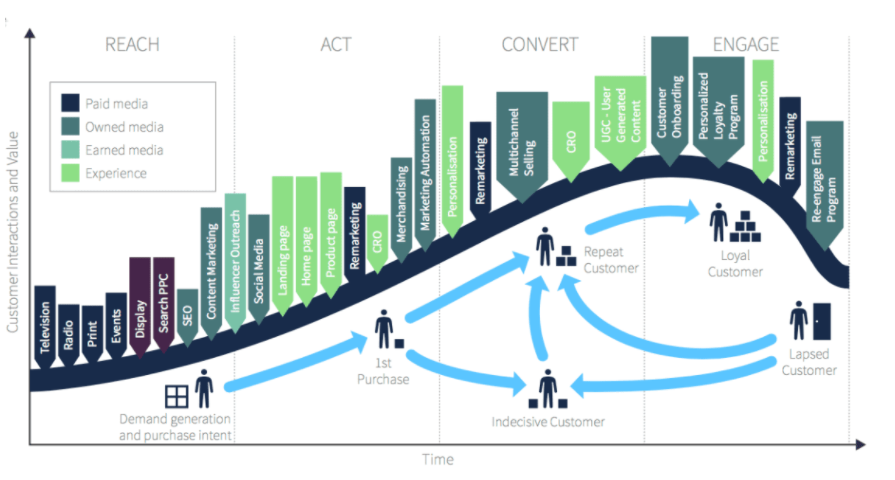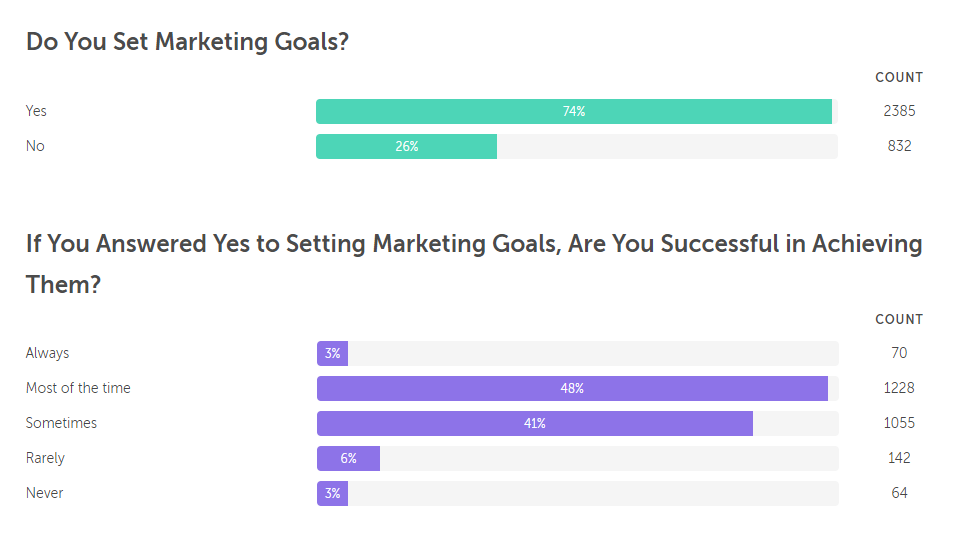With digital marketing tactics and strategy constantly evolving, it’s more important than ever for businesses to address challenges and optimize future initiatives. In 2022, you’ll want to focus your budget on top marketing goals for manufacturers that impact your bottom line and keep customers interested.
In this article, you’ll discover key marketing challenges and goals to help you stay innovative and profitable in the new year. With marketing budgets having dropped 5% since the pandemic, marketers face the challenge of driving business results with more cost-effective techniques and better goals in place.
Ready to learn more? Let’s dive in!
Key Takeaways
- Always start with an overarching strategy to avoid pointless random acts of marketing
- Combining traditional and digital marketing tactics is the best way to target your audience
- You’ll need to find new ways to stay relevant with your customers through channel engagement and technology
- Develop SMART goals for every marketing objective to keep your team accountable
Should You Invest in Digital Marketing?
After each year, many businesses look towards emerging trends to set digital marketing goals and learn from past misses. If you’re looking at performance results and wondering if you should continue to invest in digital marketing — the short answer is a resounding “absolutely yes.” Digital marketing allows you to connect with your audience throughout their entire customer lifecycle to make deeper connections that ultimately result in more conversions.


Here are a few challenges that digital marketing can help solve for your manufacturing company:
- Improves your position in search results – 68% of purchases start with an online search!
- Understand your target audience’s behavior on digital channels
- Visibility around performance metrics to determine your platform’s effectiveness
- A holistic marketing strategy that provides multiple touchpoints through social, email, and more
- The ability to manage your budget through strategic bidding strategies
- Fosters cross-functional alignment between your sales and marketing teams
With digital marketing, not only can you better target your key consumer audiences, but it also allows you to outrank your competitors by providing more impactful and optimized campaigns.
6 Top Marketing Goals for Manufacturers to Overcome
Whether you’re new to digital marketing or an experienced professional, setting and overcoming goals can be a double-edged sword. While it keeps your team incentivized to achieve high-level business results, it can take away from prioritizing your customer’s needs. You’ll want to set achievable customer-centric goals instead of only focusing on the numerical metric.
To help you get started, here are the top marketing goals for manufacturers to overcome and achieve better results for your customers:
1. Overcoming Culture
Depending on your industrial industry, you may feel a cultural resistance to implementing digital marketing instead of traditional tactics and vice versa. Due to its more local reach and reliable conversions, many manufacturer marketers gravitate towards conventional tactics, such as print, radio, and direct mail. However, digital marketing channels like social media and PPC advertising have become increasingly popular as technology advances.
While traditional marketing remains a significant revenue driver, digital marketing allows you to interact more openly with customers on their preferred platforms. Instead of conforming to an inbound or outbound strategy, consider using both methods in conjunction to follow your customer’s lifecycle. If you’re looking for a more long-term growth strategy, using both ways offers your customers more diversity and opportunities to connect with your brand.
2. Staying Relevant
A big part of any digital marketing strategy is staying relevant with your target audience, especially when marketing trends and technology evolve. While the marketing ecosystem is saturated, you can still stand out against your competitors and engage with customers more authentically.
Here are a few best practices to cut through the noise:
- Build buyer personas and study user behavior to understand how you can target your customer’s needs
- Create consistent branding with every touchpoint, so your business is memorable
- Test, optimize, and maintain the technology that allows you to automate processes
- Amplify digital channels that drive performance and avoid platforms that your customers don’t spend time on
- Develop valuable content that positions your brand as a thought leader and converts
- Monitor your competition’s key messages to differentiate and improve your future campaigns
3. Integrating the Right Tech Stack
While you may feel tempted to buy the latest and greatest technology, it’s more important to focus on a few key platforms that amplify your digital marketing strategy without breaking your budget.
Not only will marketing technology help you manage day-to-day tasks, but it also enables you to earn a competitive advantage by engaging with customers in more convenient ways. For example, only 30% of companies currently offer social messaging, live chat, and bots.
Depending on your chosen digital channels, consider investing in the following platforms:
- Social media: Sprout Social, Hootsuite, or Sprinklr
- Email marketing: Hubspot, Mailchimp, or Constant Contact
- Search engine optimization: Semrush, Moz, or Ahrefs
- Conversion optimization: ClickFunnels, Unbounce, or Optimizely
- Lead enrichment: Clearbit or Datanyze
- Lead capture: OptiMonk, Typeform, or Mailmunch
- CRM: Hubspot, Salesforce, or Pipedrive
- Marketing automation: Hubspot, ActiveCampaign, or SharpSpring
4. Hiring Top-Tier Talent
Whether you’re a lean marketing team, looking to grow, or outsourcing roles, hiring top-tier talent is a goal for many manufacturers who want to scale. However, with the world shifting to a remote workforce and employees having more options than ever before, your recruitment needs to be competitive.
Before writing out the job description, consider your ideal candidate. How many years of digital marketing experience should they have? Are they channel experts or generalists? Defining your candidate will allow you and your team to invest in quality applicants that measure up to your company’s standard.
When you start doing talent outreach, your in-house or freelance marketing team should have the following skills:
- Strong marketing skills and knowledge
- Experience in your industry
- An understanding of current digital marketing trends
- Willingness to learn your business processes and needs
- Initiative and autonomy to work independently when needed
- Availability and responsiveness to any outreach
Of course, when looking to hire top talent, you’re also searching for the X factor that separates them from the other applications. To help determine which candidate is the right pick, consider using peer panel interviews to assess how they would collaborate on your actual team.
5. Measuring Campaign Results
Accurately measuring results is the only way to understand the success of your digital marketing tactics. However, manufacturers often face manual, time-consuming processes that make it impossible to track performance effectively.
Instead of relying on best guesses and gut reactions, you need to leverage technology and data to make smarter digital marketing decisions. Before launching a campaign, ensure you have goals, KPIs, and a visible dashboard in place. You can do this through resources like Google Analytics, social media insights, and your customer relationship management (CRM) platform data.
For example, if your goal is to improve conversions in your LinkedIn campaign, you first determine your lead baseline and how many conversions you need to meet the goal. From there, develop UTM (Urchin Tracking Module) (UTM) tracking codes for any outbound links to understand where your traffic is coming from. With the tracking codes, you’ll be able to create a dashboard in your CRM platform to analyze incoming conversions. Monitor performance and optimize your messaging to improve results as the campaign continues.
6. Avoiding Complacency
The old phrase “don’t fix it if it isn’t broken” doesn’t always apply to marketing. Sure, you want to engage with your customers on their preferred platforms and invest your dollars in channels that you know will perform. However, it’s also essential to keep your finger on the pulse for new trends to understand your customers’ next steps.
To avoid falling complacent and blending with your competitors, you can:
- Ask your customers for feedback on how you can improve
- Study what types of content your customers prefer
- Update your customer journey mapping to find gaps
- Study industry publications, websites, and podcasts to track upcoming trends
How to Set Achievable Marketing Goals for Manufacturers
Marketing objectives revolve around selecting a target number or metric for your team to work towards. Depending on your company processes, you’re most likely working towards writing or updating your 2022 marketing goals to layer into the organization’s objectives.
Goal-setting marketers are 376% more likely to report performance success, and 70% of the most organized professionals achieve their goals. Before you finalize your marketing goals for manufacturers, you need to ensure they’re specific, measurable, attainable, realistic, and time-bound (SMART).
- Specific: Select the metric you want to improve, like customers, visitors, or leads
- Measurable: Gauge your campaign or team’s progress by assigning a specific percentage
- Attainable: Set your goals on data, not assumptions, to avoid biting off more than you can chew
- Relevant: Choose goals that impact overall company objectives and matter to your industry
- Time-bound: Attach deadlines to help you perform consistently
To develop goals based on company objectives, you need to determine how much revenue you need to create, the closing rate, the average deal size, and the number of leads required to achieve these results. Ensure you create monthly and quarterly benchmarks to keep your marketing team on track.\

Growing Your Business with Digital Marketing Strategies
If you’re ready to boost your bottom line, it’s essential to kickstart your digital marketing strategy by staying on track with your goals. While you may want to test every channel and campaign, consider focusing on a few critical objectives like investing in one new martech tool and hiring a marketing manager to help you get started. From there, you’ll be able to scale your strategy and drive business results.
Ready to grow your digital marketing strategy? Get started with Shanahan Strategy Inc.

